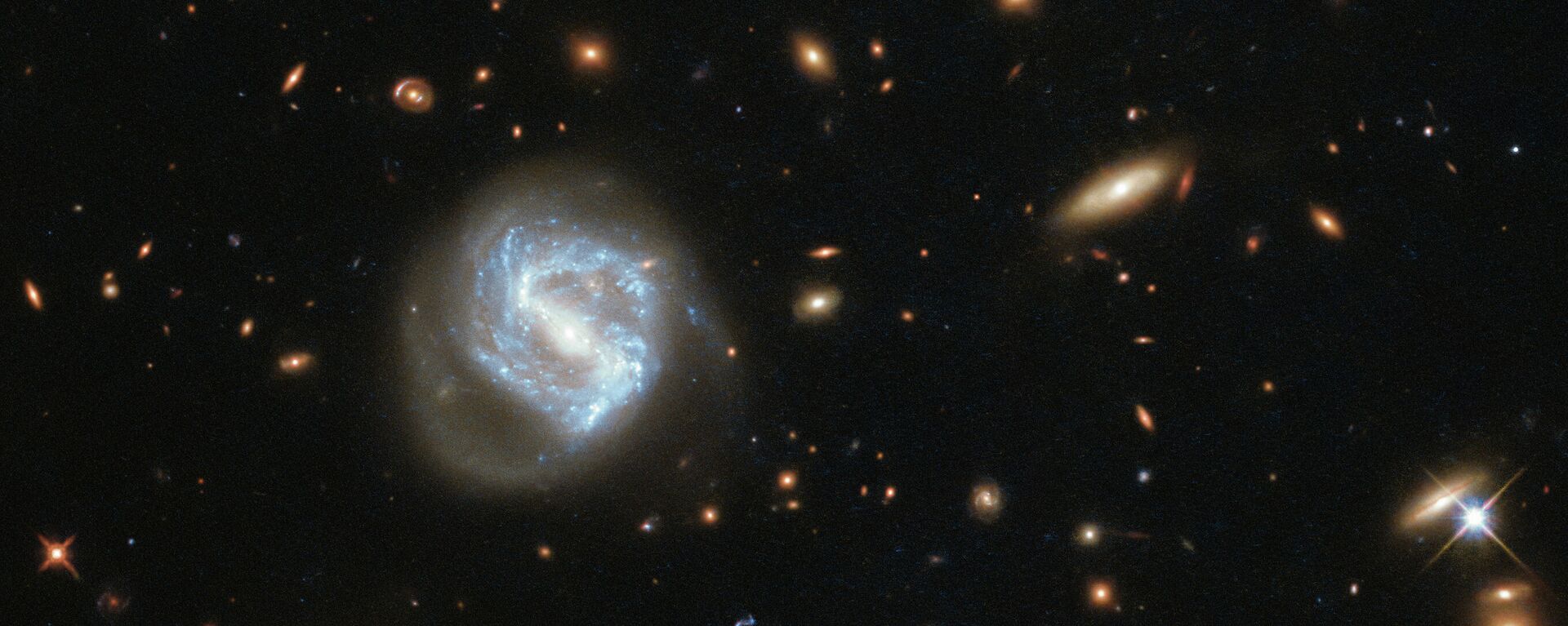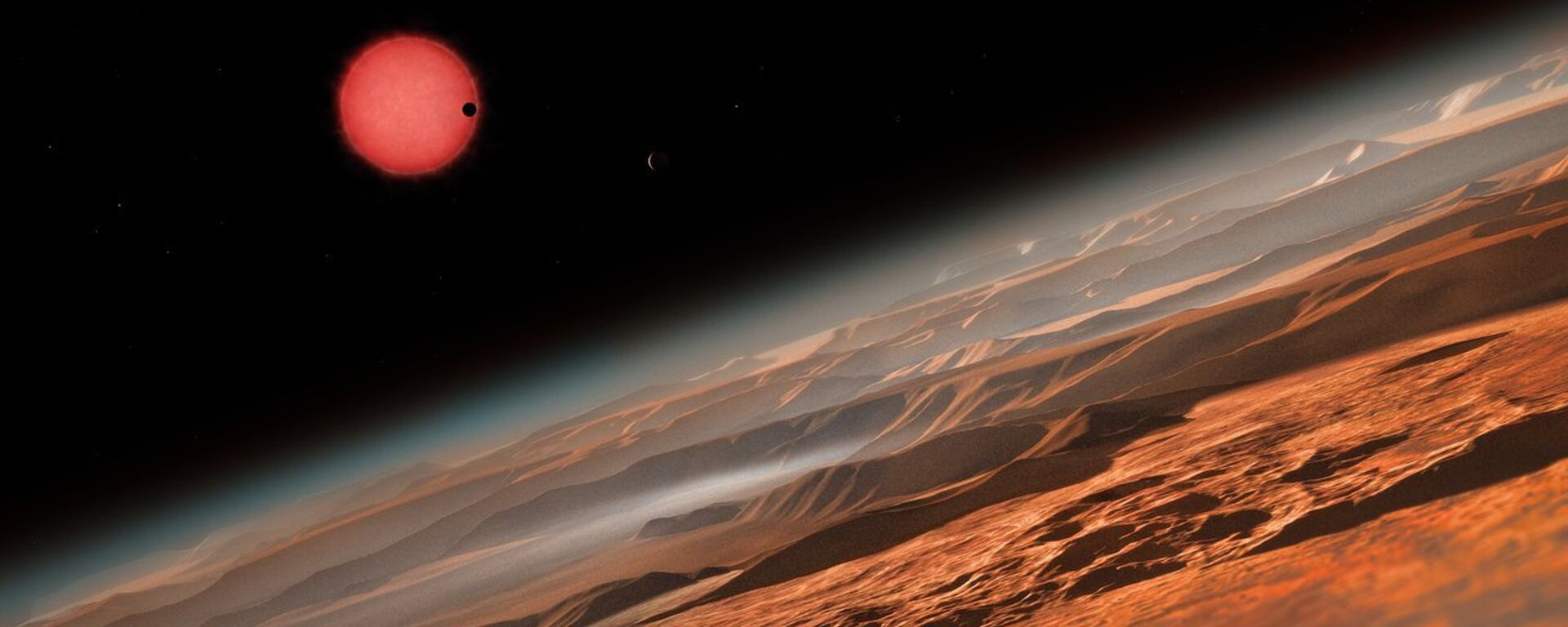https://sputnikglobe.com/20220609/astronomers-detect-weird-radio-frequency-radiation-burst-from-galaxy-far-away-1096136273.html
Astronomers Detect 'Weird' Radio Frequency Radiation Burst From Galaxy Far Away
Astronomers Detect 'Weird' Radio Frequency Radiation Burst From Galaxy Far Away
Sputnik International
Fast radio bursts (FRBs) are very short bursts of radiation (only about a millisecond in duration) that flare brightly at radio frequencies.The majority of... 09.06.2022, Sputnik International
2022-06-09T00:08+0000
2022-06-09T00:08+0000
2023-04-12T16:57+0000
science & tech
galaxy
astronomy
radio
space
https://cdn1.img.sputnikglobe.com/img/107881/92/1078819205_0:160:3073:1888_1920x0_80_0_0_5d8915f14ffc49569a8369c67fc973b7.jpg
Just the second-ever example of a very active, repeated Fast Radio Burst with a confined source of weaker but persistent radio emission between bursts has been discovered by astronomers, revealing its "weird" nature, according to new research published in the journal Nature.The discovery raises new questions regarding the nature of these enigmatic pulses of energy, as well as their utility as research tools into the nature of intergalactic space. The pulse, initially spotted in 2019, was studied using the National Science Foundation's Karl G. Jansky Very Large Array (VLA) and other telescopes, according to the research.The pulse, designated as FRB 20190520B, was discovered by China's FAST (Five-hundred-meter Aperture Spherical radio Telescope). On May 20, 2019, the burst reached Earth, and data from that telescope was discovered in November of that year. Unlike many other FRBs, 20190520B reportedly releases frequent, repetitive bursts of radio waves, according to follow-up observations.The object's location was established by measurements with the VLA in 2020, which allowed visible-light studies with the Subaru telescope in Hawaii to demonstrate that it is in the outskirts of a dwarf galaxy roughly 3 billion light-years from Earth. Between bursts, the object produces weaker radio waves, according to the VLA data.According to Casey Law, an astronomer with Caltech who was part of the research team, these features suggest that it looks similar to the very first confirmed observation of a persistently active FRB.According to the scientist, that discovery was significant since it provided the first information on an FRB's environment and distance. However, the 2016 object, known as FRB 121102, was distinguished from all other known FRBs by its combination of repetitive bursts and continuous radio emission between bursts, which came from a compact location.The distinctions between FRB 20190520B and FRB 121102, as well as all the others, support the hypothesis that there are two types of FRBs, the researchers said. The astronomers speculate that FRBs could be produced by two separate mechanisms or by objects that function differently at different stages of their existence. The superdense neutron stars left over after a big star explodes as a supernova, or neutron stars with ultra-strong magnetic fields, known as magnetars, are reportedly the most likely producers of FRBs.According to the Science Daily, the efficacy of FRBs as tools for examining the material between them and Earth is cast into doubt by one feature of FRB 20190520B. Astronomers frequently study the effects of intervening material on radio waves radiated by faraway objects in order to understand more about that flimsy material. When radio waves flow across space containing free electrons, one such effect happens. Higher-frequency waves travel faster than lower-frequency waves in this scenario. This effect, known as dispersion, can be studied to determine the density of electrons in the space between the object and Earth, or to offer a rough estimate of the distance to the object if the electron density is known or assumed. The effect is often used to calculate pulsar distances.The galaxy where FRB 20190520B occurs is estimated to be roughly 3 billion light-years away from Earth, according to an independent assessment based on the Doppler shift of the galaxy's light induced by the expansion of the Universe. The burst's signal, on the other hand, has a level of dispersion that would normally indicate a distance of 8 to 9.5 billion light-years. FRB 20190520B may be a "newborn," still surrounded by dense material blasted by the supernova explosion that left behind the neutron star, according to the astronomers. The dispersion of the burst signals would similarly decrease as that substance degrades. According to them, the recurring bursts may be a feature of younger FRBs and fade with age in this scenario.One of the most interesting features of the FRBs is that the majority of these outbursts have only been observed once: they appear out of nowhere, explode once, and then vanish. As a result, they're nearly impossible to forecast, as well as trace and examine. The FRB that was identified in the Milky Way reportedly came from a magnetar, a type of dead star, implying that magnetar eruptions are responsible for at least some FRBs.
https://sputnikglobe.com/20220608/cosmic-dawn-scientists-say-first-stars-formation-ended-over-one-billion-years-after-big-bang-1096133360.html
https://sputnikglobe.com/20220604/astronomers-find-super-earth-four-times-bigger-than-ours-in-close-stars-habitable-zone-1095992066.html
Sputnik International
feedback@sputniknews.com
+74956456601
MIA „Rosiya Segodnya“
2022
News
en_EN
Sputnik International
feedback@sputniknews.com
+74956456601
MIA „Rosiya Segodnya“
Sputnik International
feedback@sputniknews.com
+74956456601
MIA „Rosiya Segodnya“
science & tech, galaxy, astronomy, space
science & tech, galaxy, astronomy, space
Astronomers Detect 'Weird' Radio Frequency Radiation Burst From Galaxy Far Away
00:08 GMT 09.06.2022 (Updated: 16:57 GMT 12.04.2023) Kirill Kurevlev
Managing Editor
Fast radio bursts (FRBs) are very short bursts of radiation (only about a millisecond in duration) that flare brightly at radio frequencies.The majority of them come from distant galaxies, while our Milky Way has only one, and they're extraordinarily bright, releasing as much energy in a moment as 500 million Suns.
Just the second-ever example of a very active, repeated Fast Radio Burst with a confined source of weaker but persistent radio emission between bursts has been discovered by astronomers, revealing its "weird" nature, according to new research
published in the journal Nature.
The discovery raises new questions regarding the nature of these enigmatic pulses of energy, as well as their utility as research tools into the nature of intergalactic space. The pulse, initially spotted in 2019, was studied using the National Science Foundation's Karl G. Jansky Very Large Array (VLA) and other telescopes, according to the research.
The pulse, designated as FRB 20190520B, was discovered by China's FAST (Five-hundred-meter Aperture Spherical radio Telescope).
On May 20, 2019, the burst reached Earth, and data from that telescope was discovered in November of that year. Unlike many other FRBs, 20190520B reportedly releases frequent, repetitive bursts of radio waves, according to follow-up observations.
The object's location was established by measurements with the VLA in 2020, which allowed visible-light studies with the Subaru telescope in Hawaii to demonstrate that it is in the outskirts of a dwarf galaxy roughly 3 billion light-years from Earth. Between bursts, the object produces weaker radio waves, according to the VLA data.
According to Casey Law, an astronomer with Caltech who was part of the research team, these features suggest that it looks similar to the very first confirmed observation of a persistently active FRB.
"These characteristics make this one look a lot like the very first FRB whose position was determined -- also by the VLA -- back in 2016," Law said, per the Science Daily report. "Now we have two like this, and that brings up some important questions."
According to the scientist, that discovery was significant since it provided the first information on an FRB's environment and distance. However, the 2016 object, known as FRB 121102, was distinguished from all other known FRBs by its combination of repetitive bursts and continuous radio emission between bursts, which came from a compact location.
The distinctions between FRB 20190520B and FRB 121102, as well as all the others, support the hypothesis that there are two types of FRBs, the researchers said. The astronomers speculate that FRBs could be produced by two separate mechanisms or by objects that function differently at different stages of their existence. The superdense neutron stars left over after a big star explodes as a supernova, or neutron stars with ultra-strong magnetic fields, known as magnetars, are reportedly the most likely producers of FRBs.
According to the Science Daily, the efficacy of FRBs as tools for examining the material between them and Earth is cast into doubt by one feature of FRB 20190520B.
Astronomers frequently study the effects of intervening material on radio waves radiated by faraway objects in order to understand more about that flimsy material. When radio waves flow across space containing free electrons, one such effect happens. Higher-frequency waves travel faster than lower-frequency waves in this scenario. This effect, known as dispersion, can be studied to determine the density of electrons in the space between the object and Earth, or to offer a rough estimate of the distance to the object if the electron density is known or assumed. The effect is often used to calculate pulsar distances.
The galaxy where FRB 20190520B occurs is estimated to be roughly 3 billion light-years away from Earth, according to an independent assessment based on the Doppler shift of the galaxy's light induced by the expansion of the Universe.
The burst's signal, on the other hand, has a level of dispersion that would normally indicate a distance of 8 to 9.5 billion light-years.
FRB 20190520B may be a "newborn," still surrounded by dense material blasted by the supernova explosion that left behind the neutron star, according to the astronomers. The dispersion of the burst signals would similarly decrease as that substance degrades. According to them, the recurring bursts may be a feature of younger FRBs and fade with age in this scenario.
One of the most interesting features of the FRBs is that the majority of these outbursts have only been observed once: they appear out of nowhere, explode once, and then vanish. As a result, they're nearly impossible to forecast, as well as trace and examine.
The FRB that was identified in the Milky Way reportedly came from a magnetar, a type of dead star, implying that magnetar eruptions are responsible for at least some FRBs.





